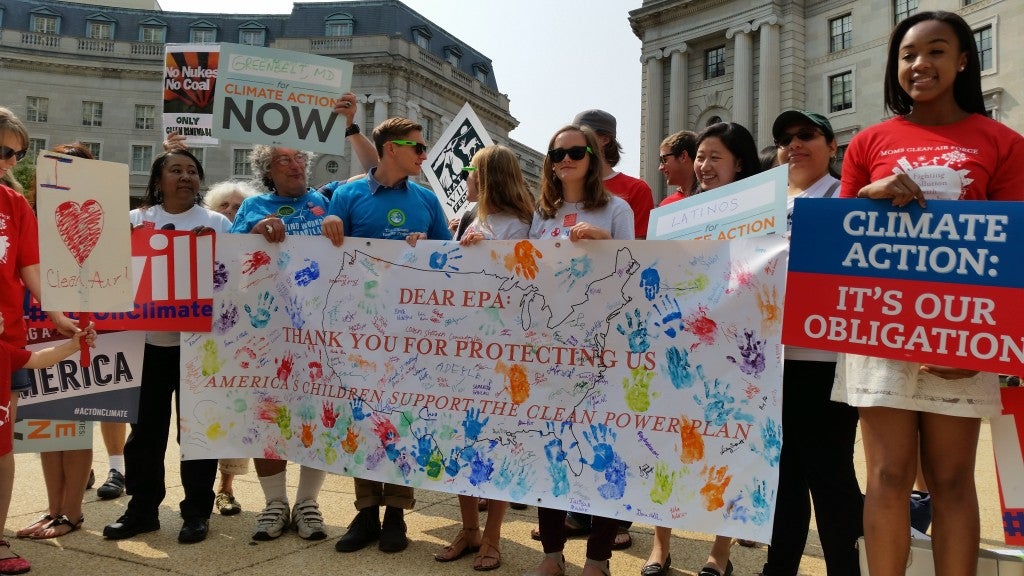The U.S. Environmental Protection Agency (EPA) is hard at work right now on the Clean Power Plan – the first ever national carbon pollution standards for power plants.
Among the many important aspects of this historic plan, we believe this: It is critical that EPA finalize carbon pollution standards for the power sector that include protective, well-designed standards beginning in 2020.
Power plants account for almost 40 percent of U.S. carbon dioxide emissions, making them the largest source of greenhouse gas emissions in the nation and one of the largest sources of greenhouse gases in the world.
The Clean Power Plan will be finalized this summer. When fully implemented, it is expected to reduce greenhouse gas emissions from the power sector to 30 percent below 2005 levels. That makes these eminently achievable and cost-effective standards integral to climate security, human health and prosperity.
The Clean Power Plan will phase in over a 15-year period, with interim standards commencing in 2020, and final standards taking effect in 2030 – and there is strong reason to believe that the interim standards covering the period 2020 to 2029 should be strengthened in the final rule.
Interim standards can help the U.S. secure near-term low-cost opportunities to reduce greenhouse gas emissions, while generating the market signals necessary to achieve the deeper reductions required in the years ahead. They also can deliver important public health benefits for our families by providing healthier and longer lives for millions of Americans. And EPA has designed the interim standards in a manner that provides considerable flexibility to states and power companies to comply while deploying their own unique solutions.
Carbon Pollution Limits that Begin by 2020 are Essential for Driving Near-term Actions to Reduce Dangerous Emissions and to Advance Climate Security
As proposed, the Clean Power Plan’s interim standards could deliver cumulative emissions reductions of more than 5 billion tons of carbon dioxide. That approaches the total annual carbon dioxide emissions for the entire United States. Protective interim standards that require states and power companies to take near-term action to reduce carbon pollution are essential to secure these climate benefits.
Interim standards are essential for mobilizing the full range of near-term cost-effective opportunities to cut pollution, as they are the only way to ensure that investments in activities that reduce carbon pollution are fully recognized and properly rewarded. This is true whether the investments are new renewable generation, customer-friendly demand side energy efficiency programs, or other low-carbon solutions.
As the cost of clean energy decreases and the heavy burden of carbon pollution increases, a near-term limit on carbon emissions helps ensure these vital solutions are deployed without delay.
Interim standards can also help drive sustained investments in one especially important area – energy efficiency. Investments in energy efficiency can lead to direct financial benefits for customers – families and businesses alike – in the form of lower electric bills.
23 states are already implementing mandatory efficiency savings targets. These efforts have been overwhelmingly successful, regularly delivering two dollars of savings to customers for every one dollar invested – and in some cases up to five dollars for every one dollar invested.
Even in those states that have been implementing these programs for a while, there is little reason to believe that they have come anywhere close to exhausting the available potential. For example, analysis by McKinsey & Company found that implementing only those efficiency measures that pay for themselves would reduce the country’s total end-use energy consumption by 23 percent by 2020 relative to a business-as-usual scenario.
Analysis by the National Academy of Sciences found that the building sector could reduce energy consumption by 25 to 30 percent between 2030 and 2035, at a cost of just 2.7 cents per kilowatt hour saved. In addition, they found that cost-effective measures could reduce industrial demand 14 to 22 percent by 2020.
For all these reasons, electricity bills are actually expected to decrease as a result of efficiency investments power companies and states make to comply with the Clean Power Plan.
Near-Term Reductions are Essential to Ensure Healthier, Longer Lives for Millions of Americans
The interim emission standards are expected to drive significant near-term public health benefits across America.
In 2020 the proposed standards are expected to prevent:
- Up to 4,300 premature deaths
- Up to 100,000 asthma attacks in children
- Up to 2,100 heart attacks
- Up to 1,500 hospital admissions
- Up to 290,000 missed school and work days
Even greater benefits are anticipated in later years.
That’s because power plants are major sources of emissions for a range of pollutants that contribute to ground-level ozone, better known as smog, and dangerous particulate pollution, better known as soot. Power plants are also a major source of emissions for pollutants that have neurotoxic or carcinogenic (cancer-causing) effects.
Power plants account for about 70 percent of U.S. total sulfur dioxide emissions and 46 percent of mercury emissions, and are important sources of nitrogen oxides. Steps taken to reduce carbon pollution under the Clean Power Plan will have the co-benefit of reducing emissions of these and other harmful air pollutants.
EPA estimates that these human health benefits outweigh the costs of compliance by a factor of seven to one.
Each year they are in effect, these important safeguards provide healthier and longer lives for Americans.
Protective Interim Standards are Flexible and Achievable
The goals of the Clean Power Plan are eminently achievable, as they are based on proven and cost-effective methods for reducing carbon pollution that many states and power companies are already demonstrating.
In addition, the Clean Power Plan provides an extraordinarily flexible structure in which states are able to craft their own path forward for reducing carbon pollution, so long as they meet the 10-year average interim target over the period 2020-2029 and then achieve the final reduction target in 2030. This flexibility provides states with the opportunity to harness their own unique opportunities and solutions in light of their own policy preferences.
When evaluating the feasibility of the standards, it is important to consider how quickly the nation’s grid is already decarbonizing. Emissions of carbon pollution from the power sector fell 15 percent from 2005 to 2014. As proposed, the Clean Power Plan only requires them to fall another 15 percent by 2030. Analysis by EIA suggests that the U.S. could cost-effectively reduce greenhouse gas emissions from the power sector about four times faster.
Here’s more evidence that the grid is decarbonizing at a considerably faster rate than what is required by EPA – in the five year period from 2007 to 2012, the Northeastern states reduced their carbon dioxide emissions from large power plants by 37 percent to 42 percent below 2005 levels. The reductions were due to a wide range of factors, including the adoption of the Regional Greenhouse Gas Initiative, shifting natural gas prices, and efficiency investments. That demonstrates the dynamic flexibility and adaptability of which the grid is capable.
This is all happening in the context of a continuously evolving and decarbonizing electric system. Since 2000, the U.S. has installed roughly 30 gigawatts of new generation capacity per year, the vast majority of which was natural gas and renewables. According to EIA, more than 20 gigawatts of utility scale renewables, natural gas, and nuclear generation are already scheduled to come online in 2015, almost half of which is wind.
Meanwhile, we continue to build new infrastructure – which can help unlock even greater opportunities.
For example, according to the Department of Energy, during the last several years more than 2,300 circuit miles of new transmission additions were constructed annually. According to FERC, there are almost 10,000 miles of proposed new transmission projects in various stages of development that have a “high probability of completion” by January 2017.
Protective interim standards will align our nation’s major investments in new infrastructure with climate security – providing lasting protections and smart investments.
Interim Standards Can Help Promote Investments that Drive Even Deeper Reductions in the Years Ahead
The cost of zero carbon generation is rapidly falling. Wind and solar are cheaper than coal – and even natural gas in a growing number of markets.
Renewable prices are expected to continue their meteoric decline. The price for photovoltaic modules has fallen 80 percent since 2007, and wind prices have fallen 64 percent since 2009.
As a result, the solar industry is expecting to build another 20 gigawatts of new generation over the next two years alone. That’s roughly equivalent to the generation of 13 mid-sized coal plants. (The average capacity factor for new utility scale solar array is around 20 percent, while the average monthly capacity factor for the coal fleet was 61 percent in 2014.)
While EPA’s building blocks assume only modest growth in renewable generation over the next 15 years, recent shifts in price dynamics suggest that the actual market opportunity could be considerable. For this opportunity to materialize, however, power companies and investors need a clear signal about the value of reducing carbon pollution from the power sector.
Providing the clear investment signal beginning in 2020 can shape the broader range of infrastructure investments expected in the coming years, and ensure that they are consistent with the low carbon future we will need if we are to stave off the worst impacts of climate change.
That broader range of infrastructure investments includes the vast miles of electric transmission and natural gas pipelines that are expected to be built in the coming years, as well as investment decisions in today’s generation fleet. More than 30 percent of coal plants are 50 years old, and approximately one in four plants do not contain controls for sulfur dioxide or nitrogen oxides.
In total, utilities appear poised to invest up to $2 trillion in new generation, transmission, and distribution infrastructure between 2010 and 2030 in order to modernize aging generating facilities and grid systems. Any delay in establishing carbon pollution standards for the power sector increases the uncertainty and increases the risk that investments could become stranded in the future.
All of this suggests that well-designed interim standards are both achievable and essential. If anything, the standards should be strengthened given the urgency of the climate challenge, the scale of change we have seen in the power sector to date, and the significant public health and economic benefits the standards can provide.
We have an opportunity as a nation to take advantage of the fact that the economics of power generation are rapidly changing. The best way for both companies and states to position themselves for a competitive advantage in the future is to think long-term and to get on the leading edge of these emerging trends. Otherwise, there is a risk of reinvesting in assets that will be left behind by a changing market, leaving shareholders and ratepayers on the hook.
The Clean Power Plan presents a real opportunity. Let’s all work together to strengthen the program, and work to deliver a vibrant low-carbon economy for the United States.













